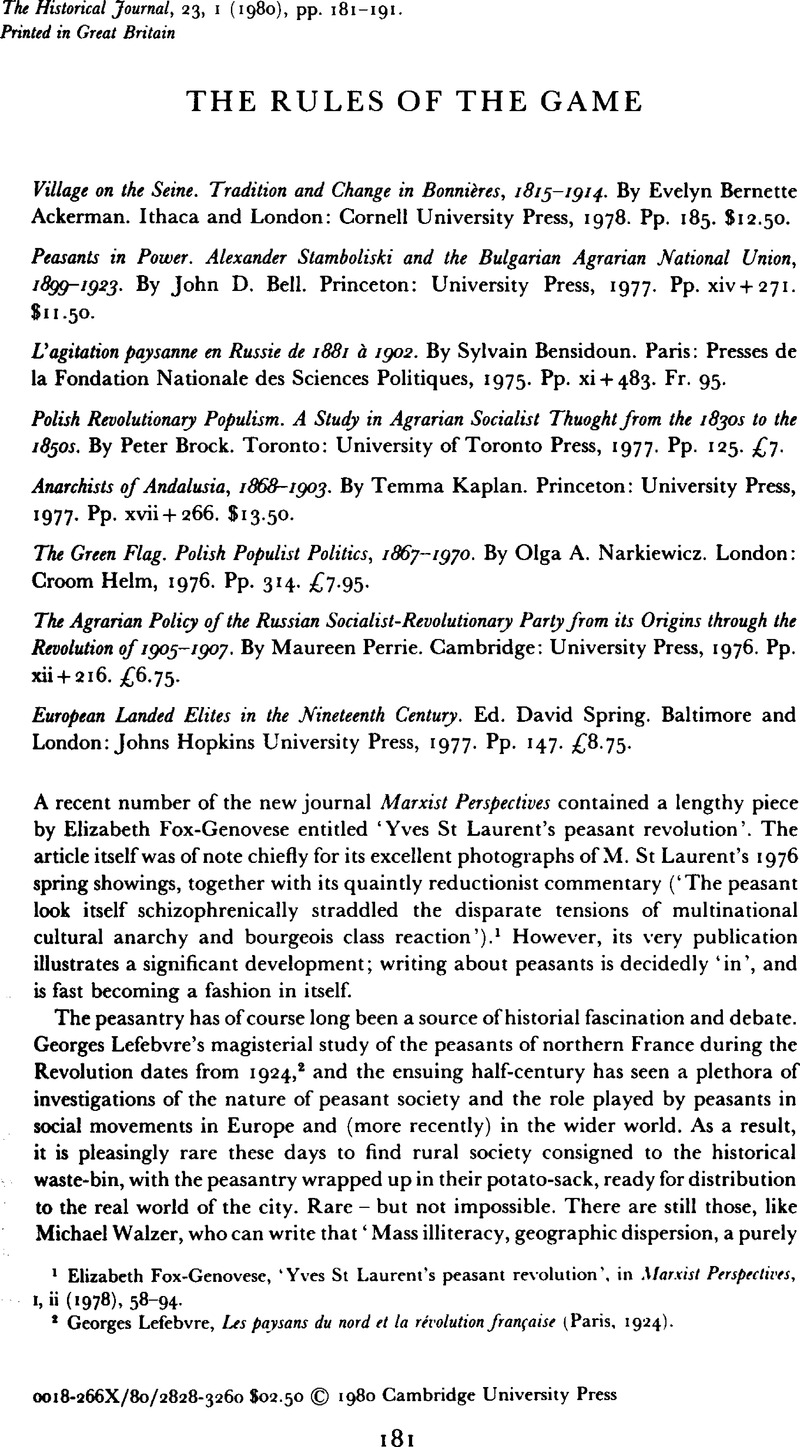No CrossRef data available.
Article contents
The Rules of the Game
Published online by Cambridge University Press: 11 February 2009
Abstract

- Type
- Review Articles
- Information
- Copyright
- Copyright © Cambridge University Press 1980
References
1 Elizabeth, Fox-Genovese, ‘Yves St Laurent's peasant revolution’, in Marxist Perspectives, i. ii (1978). 58–94.Google Scholar
2 Georges, Lefebvre, Les paysans du nord et la révolution française (Paris, 1924).Google Scholar
3 Michael, Walzer, ‘ A theory of revolution’, in Marxist Perspectives ii, i (1979), 30–46. Since Walzer, in this same article, claims that Thermidor’ represents the fulfillment of Marx's vision of revolutionary politics’ (p. 43), we should not be surprised at his somewhat blinkered approach to the peasantry!Google Scholar
4 Gavin, Lewis, ‘The peasantry, rural change and conservative agrarianism: Lower Austria at the turn of the century’ in Past and Present, no. 81 (Nov. 1978), 119–43.Google Scholar
5 See, inter alia: Arnold, Bauer, Chilean rural society from the Spanish conquest to 1930 (Cambridge, 1975);Google ScholarPierre, Bourdieu and Sayad, Abdel M., Le déracinement: la crise ľagriculture traditionnelle en Algérie (Paris 1964);Google ScholarChalmers, Johnson, Peasant nationalism and Communist power: the emergence of Revolutionary China, 1937–1945 (Stanford, 1962);Google ScholarJohn, Womack, Zapata and the Mexican Revolution (New York, 1969).Google Scholar There are two very interesting articles by Robert, Brenner for the earlier European period: ‘Agrarian class structure and economic development in pre-industrial Europe’, in Past and Present, no. 70 (Feb. 1976), 30–75;Google Scholar‘The origins of capitalist development: a critique of neo-Smithian Marxism’, in New Left Review, no. 104, pp. 25–92.Google Scholar
6 For a stimulating discussion of these, and many other, matters, see Theda, Skocpol, States and social revolutions (Cambridge, 1979).Google Scholar
7 Taking Braudel as the starting point for such an approach implies the view, which I take, that Annales ESC has moved some distance from the original path charted for it by its founders, Lucien Febvre and Marc Bloch.
8 Jerome, Blum, The end of the old order in rural Europe (Princeton, 1978).Google Scholar
9 See Laurence, Wylie (ed.), Chanzeaux: A village in Anjou (Cambridge, Mass, 1966).Google Scholar Also Laurence, Wylie, Village in the Vaucluse (New York, 1964).Google Scholar
10 On migration see in particular Abel Chatelain, Les migrants temporaires en France de 1800 à 1904 (Villeneuve d’Ascq, Université de Lille), iii, 1976); Alain, Corbin, Archaisme et modernité en Limousin au dix-neuvième siècle, 1845–1880 (Paris, 1975);Google ScholarL’Esodo rurale e lo spopolamento delta montagna nella societa contemporanea (Atti de Convegno Italo-Svizzera, May 1965) (Milan, 1976), especially pp. 15–25; Jean, Pitié, Exode rurale et migrations intérieures en France: l’ exemple de la Vienne et du Poitou-Charentes (Poitiers, 1971);Google ScholarJohn, Salt & Hugh, Clout (eds.), Migration in post-war Europe (Oxford, 1976).Google Scholar
11 ‘La paysannerie francaise, y compris la petite paysannerie parcellaire, fut … un des principaux obstacles à la révolution socialiste dans un pays marquè par la combativite exceptionnelle et exemplaire de la classe ouvrière.’ Nicos, Poulantzas, Les classes sociales dans U capitalism d'aujourd’hui (Paris, 1974), pp. 355–6.Google Scholar
12 See Tony, Judt, Socialism in Provence: a study in the origins of the modem French Left (Cambridge, 1979), p. 257.Google Scholar
13 See Bauer, Chilean rural society, pp. 80, 100, 114, ii. 26. For a lengthier discussion of this theme, see Judt, Socialism in Provence, pp. 275–80.
14 Bensidoun is generally rather vague when it comes to explaining things he has a tendency to end a discussion of the complex range of causal factors with the conclusion that it varied ‘selon les circonstances’. His dense study is rather like that of Garner (Pqysans du Beaujolais et du Lyonnais 1800–1970, Grenoble, 1973, 2 vols.); both of them represent the less laudable features of the classic French thèse, where an obsession with detail and, above all, structure, permits the author to minimise the attention paid to argument and explanation.
15 Lewis, loc. cit, discusses the ‘ integrative’ function of peasant-orientated parties (see especially page 121), but he takes it too far - in a limited sense of the term, all political parties function to integrate their clients into the political system. The important thing is to distinguish between what we claim was going on, and what the clients themselves had in mind when they voted or rebelled - and it is a little risky to suppose, as Lewis seems to, that they, too, had ‘integration’ in mind as a political goal.
16 See Tudesq, A.-J., Les Grands notables en France 1840–49 (2 vols., Paris, 1964);Google ScholarJerome, Blum, Noble landowners and agriculture in Austria 1815–1848 (Baltimore, 1948);Google ScholarJerome, Blum, Lord and peasant in Russia from the ninth to the nineteenth century (Princeton, 1961). One has the sense, from the work of Blum and others, that the particular identity of the Russian state goes a long way towards answering Blum's own question - but it leaves open, of course, the general problem.Google Scholar
17 Hans-Jurgen, Piihle, Politische Agrarbewegungen in kapitalistischen Industriegesellschaften (Göttingen, 1975), especially pp. 11–27.Google Scholar




